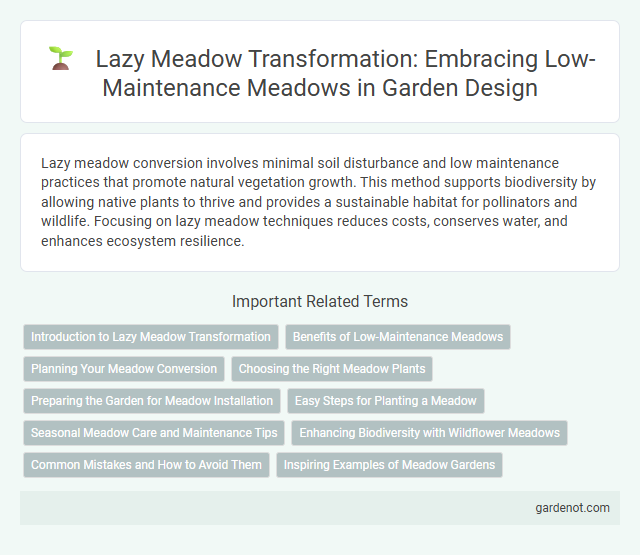Lazy meadow conversion involves minimal soil disturbance and low maintenance practices that promote natural vegetation growth. This method supports biodiversity by allowing native plants to thrive and provides a sustainable habitat for pollinators and wildlife. Focusing on lazy meadow techniques reduces costs, conserves water, and enhances ecosystem resilience.
Introduction to Lazy Meadow Transformation
Lazy meadow transformation involves converting underused grassy areas into vibrant, low-maintenance ecosystems that boost biodiversity. This method emphasizes native plant species thriving with minimal intervention, reducing water consumption and enhancing soil health. The transformation supports pollinators and wildlife, creating sustainable, visually appealing landscapes.
Benefits of Low-Maintenance Meadows
Low-maintenance meadows significantly reduce water consumption and eliminate the need for frequent mowing, promoting sustainable landscaping. These ecosystems enhance biodiversity by providing habitats for pollinators and native wildlife, contributing to ecological balance. Cost savings arise from fewer inputs like fertilizers and pesticides, making lazy meadows an environmentally friendly and economical choice.
Planning Your Meadow Conversion
Planning your lazy meadow conversion involves selecting a site with well-drained soil and minimal disturbance to promote native wildflower growth. Prioritize planting a diverse mix of perennial grasses and wildflowers adapted to local climate conditions to enhance biodiversity and support pollinators. Timing the conversion in early autumn or spring maximizes seed germination and establishment of meadow species.
Choosing the Right Meadow Plants
Selecting the right meadow plants is crucial for transforming a lazy meadow into a vibrant, low-maintenance habitat. Native grasses like Festuca rubra and wildflowers such as Achillea millefolium thrive in poor soils and support local biodiversity. Prioritize species with staggered blooming periods to ensure continuous pollinator activity throughout the growing season.
Preparing the Garden for Meadow Installation
Preparing the garden for meadow installation involves clearing existing turf and invasive plants to create an optimal seedbed for native wildflowers and grasses. Soil conditioning through aeration and light raking ensures proper seed-to-soil contact, enhancing germination rates for a thriving lazy meadow. Selecting locally adapted seed mixes tailored to the soil type and climate supports biodiversity and sustainable growth.
Easy Steps for Planting a Meadow
Planting a Lazy meadow involves selecting native wildflowers and grasses adapted to local soil and climate conditions for optimal growth and biodiversity. Preparing the soil by removing existing vegetation and loosening the ground ensures seeds establish well and reduces competition. Regular watering during the initial weeks supports seed germination, while minimal mowing after establishment encourages a healthy, natural meadow habitat.
Seasonal Meadow Care and Maintenance Tips
Lazy meadows require minimal intervention but benefit greatly from seasonal care to maintain biodiversity and aesthetic appeal. Mowing once or twice a year, ideally late summer after most plants have seeded, supports native flora and pollinators. Removing cuttings prevents nutrient buildup, promoting long-term soil health and sustained meadow vitality.
Enhancing Biodiversity with Wildflower Meadows
Lazy meadow conversion enhances biodiversity by fostering diverse wildflower species that attract pollinators such as bees and butterflies. Introducing native wildflowers creates habitats for various insects and small mammals, boosting ecological balance and soil health. This sustainable approach supports wildlife conservation while enriching the visual landscape.
Common Mistakes and How to Avoid Them
Lazy meadow conversion often suffers from poor soil preparation, leading to weak plant establishment and increased weed growth. Neglecting proper site assessment and using inappropriate seed mixes results in low biodiversity and reduced ecological benefits. Ensuring thorough soil testing, selecting native species suited to local conditions, and consistent maintenance prevents these common pitfalls.
Inspiring Examples of Meadow Gardens
Lazy meadow gardens transform underused spaces into vibrant ecosystems teeming with native wildflowers, grasses, and pollinators. Examples like the High Line in New York City and the Sheffield Urban Meadow Project showcase how integrating diverse plant species enhances biodiversity while reducing maintenance. These inspiring designs promote sustainability, attract wildlife, and offer visually stunning natural landscapes in urban environments.
Lazy meadow Infographic

 gardenot.com
gardenot.com